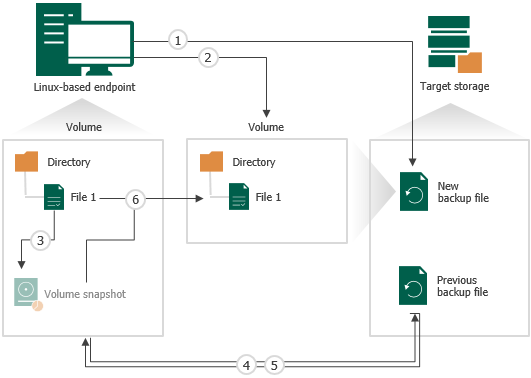How File-Level Backup Works
During file-level backup, Veeam Agent performs the following operations for every backup job session:
- When a new job session starts, Veeam Agent creates a backup file in the target location.
- In the backup file, Veeam Agent creates a disk. The disk contains a volume with the ext4 file system.
- Veeam Agent creates a snapshot of the volume which data you want to back up. The snapshot is created on the volume that has enough free disk space to contain the snapshot data. To create a snapshot, Veeam Agent uses the Veeam Agent for Linux Driver.
The snapshot helps make sure that the data on the volume is consistent and does not change at the moment of backup. If a data block is about to change on disk during backup, Veeam Agent will copy this block to the snapshot. After the data block is overwritten on the source location, its original copy will remain intact in the snapshot.
TIP |
Consider the following:
For example, you have a 1 GB file, and since the previous backup session only one data block of this file has changed. In case of the file-level backup, Veeam Agent will send the whole 1 GB file to the target again. |
- [For incremental backup] To detect files that changed on the Veeam Agent computer since the previous backup session, Veeam Agent reads file metadata and compares last modification time of files in the original location and files in the backup created during the previous job session. If the file has modification time later than the previous job session start time, Veeam Agent considers the file as changed.
To learn about full and incremental backup, see Backup Chain.
- Veeam Agent copies data that you selected for backup to the target location. As part of this process, Veeam Agent performs the following operations:
- Enumerates all files in the source location.
- For each enumerated file, creates a target file in the volume inside the backup file.
- Opens the source and the target files.
- Copies file data to the target location from the following sources:
- Data blocks that did not change on disk during backup are transferred from the source volume.
- Data blocks that changed on disk during backup are transferred from the snapshot.
- Closes the source and target files.
After all backed-up files and directories are transferred, Veeam Agent removes the snapshot.
